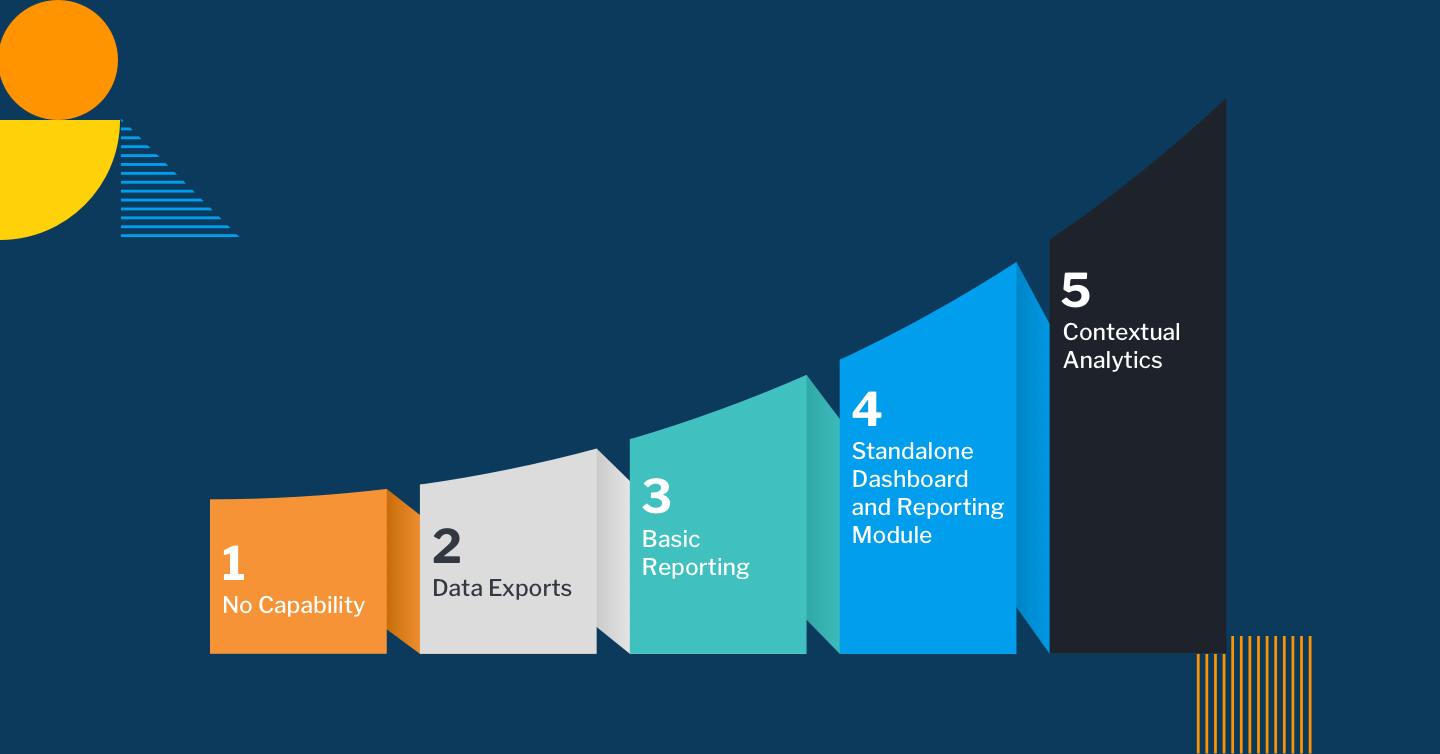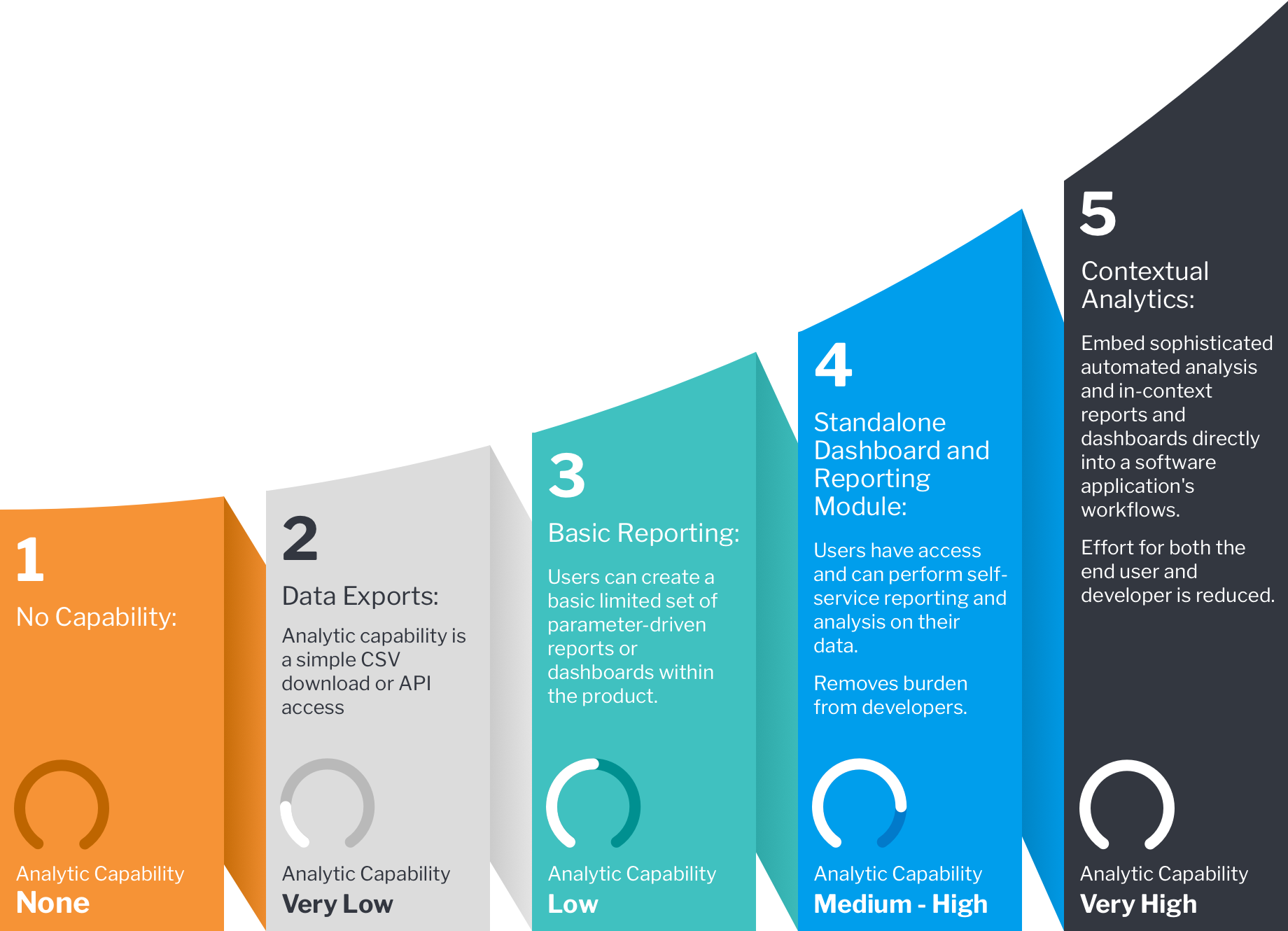
The embedded analytics maturity curve - where does your software or app rank?
An exceptional embedded analytics offering is underpinned by the right strategy - and this all starts with a clear vision. To maximize the value of data assets, you may need to recognize and then address where your product may need to improve its maturity level. To do this, it’s time to focus on where your analytics development capability and tooling is today.
The embedded analytics maturity curve highlights the value of analytics to your end-user and the concentration of analytical development effort through 5 stages. By understanding where you fit in the curve, you can determine what the next exciting new stage can bring to your application’s analytical experience.
This blog defines and details the maturity model of embedded analytics to provide a helpful fundamental framework for planning the introduction and/or refining of an embedded analytics platform into your software. This will help you understand where opportunity lies with analytics within your current application, and the exact embedded analytics use cases that pertain to your business objectives.

Embedded Analytics: Stage 1 - No Capability
Software vendors in the first stage of the embedded analytics maturity curve are those focused on building the initial Minimum Viable Product (MVP) for their new application and getting it market-ready.
Reporting capabilities, such as dashboards and report generation, are rarely included in the MVP. More often than not, if you’re a software vendor in this stage, you’ve chosen to ship your product with little to no analytic capability, with the intention of pursuing embedded analytics capability in the future.
The limitations of this low maturity stage means you might be potentially severely constrained when you eventually attempt to introduce and then modernize your embedded BI features.
It’s an uphill battle to introduce analytics at a later stage when starting from Stage 1, but vendors with low maturity can quickly learn from the success of more mature organizations to speed up modernization of your embedded analytic capabilities.
There’s still plenty of opportunity to take your data analytics capabilities to the next level.
Analytic Value = None
Embedded Analytics: Stage 2 - Data Exports
This is the stage in the embedded analytics lifecycle when your customers and end-users start demanding the ability to analyze their data stored in their work application, having recognized the need to have some form of report building and consumption for their day-to-day decisions.
If you’re a vendor in this stage, traditionally you may have catered to these initial requests with a simple CSV download or gave API access to allow users to analyze data in their preferred tool.
However, the main limitation of this stage is that you, as the vendor, still need to build all analysis from scratch - this leaves a burden of time and expertise on your customers.
Ultimately, this does not provide them with an extensive level of analytical capability. Your users might typically then turn to third-party, external, standalone reporting tools to fulfil their BI needs.
Analytic Value = Very Low
Future Scenario: If you eventually want to provide its own reporting solution, you will face and have to address a huge migration nightmare - because you will have to offer comparable functionality to the many disparate and third-party reporting tools used by your customers.
Embedded Analytics: Stage 3 - Basic Reporting
Often the result of an in-house developed solution, if you’re a software vendor in this stage, you can provide the ability to create basic parameter-driven reports within the application. However, the set of reports or dashboards is limited and users can’t create their own custom analysis.
The challenge you face being in this stage is that the customer’s need for better insights to drive their decision-making is growing very fast - often faster than what your developers can accommodate currently in a timely manner - as are user requests for new reporting capabilities.
What ends up happening is your product developers get bogged down in fulfilling report creation requests, instead of developing value-added features for the core solution which can improve the user experience, add business benefits and elevate the value of the application overall.
Instead, most of the analytic workload is shifted away from the customer and onto developers.
Analytic Value = Low.
Future Scenario: The need to migrate customers from legacy (in-house/home-grown BI) to new (embedded) provides an opportunity to create an improved experience for all customers simultaneously with a uniform migration experience. Assuming more functionality is being added, it provides you an opportunity to meet current functionality at current cost and then up-sell users new and improved features, increasing the average deal size per customer.
Embedded Analytics: Stage 4 - Standalone Dashboard and Reporting Module
This is the stage where vendors achieve the baseline of what embedded analytics is today.
If you’re in this stage, your software now allows the end-user to perform self-service reporting and analysis, with out-of-the-box dashboards and reports that also enable customers to create their own bespoke analytic content, using user-friendly tools from predefined, secure data sets.
Your embedded analytics component is accessed as a standalone module, meaning users have better access to their data, and developers are freed from having to create bespoke reports. BI is more self-service, feature-rich and user-friendly for customers than any other previous stage.
Some of the major benefits in modernizing with embedded analytics and reaching this part of the analytics maturity curve include:
- Ability to create exceptional analytical experiences for customers
- Focus dev resources on uplifting core product rather than report creation requests
- New upsell and revenue opportunities
- Sustainable competitive advantage
However, while being in this stage brings vendors many proven benefits, embedded analytics itself does not readily guide your users toward optimal use of your software.
Why? Because user workflows and decision-making is still made without inline support of data. What this means is users still need to context switch (change windows, look elsewhere outside of their application) from the core product workflows to access insights, breaking their workflow.
This one remaining limitation formed the creation of the fifth and newest stage - contextual analytics.
Analytic Value = Medium-High.
Future Scenario: When customer needs change or their competitors enter the market with a stage 5 solution, if the current product does not support stage 5, the software vendor will have a choice - to either continue providing this solution and lagging the market, or do a full rip and replace. Any investments and content created in the current version will have to be migrated into the second. Alternatively, you may consider running with 2 solutions - one for contextual and another for self-service BI.
Embedded Analytics: Stage 5 - Contextual Analytics
This is the end-goal - the latest and greatest form of embedded analytics you need today.
Contextual analytics is the ability to embed sophisticated automated analysis and in-context reports and dashboards directly into a software application's workflows, which then guides your users to make optimal use of your product and improve your product's business benefits.
It accomplishes this through the inclusion of blended analytics and bi-directional workflows, with only a minimal workload for both your end users and developers - making BI more seamless.
With contextual analytics, your end-users now derive far more significant value from their analytics. Why? Their insight discovery process is now guided, dynamic and seamless with the overall software application experience. Because a lot of the analytic workload is pre-defined or automated, the effort for both the end user and your developers is also significantly reduced.
For long-term future-proofing and providing highly differentiated analytics user experiences, contextual analytics is the best offering of the embedded analytics model today. By letting you merge analytics deeper into core workflows, contextual analytics brings about new experiences and workflows that combine insights and actions within your application, optimize the use of your core software app and increase the business benefits everyone derives from using it.
The best part about contextual analytics is it’s no longer the sole domain of data experts, as it is now accessible for everyone, by using modern embedded analytics platforms like Yellowfin BI.
Analytic Value = Very High.
Understanding the Embedded Analytics Maturity Model: Next steps
It’s clear as software owners continue to move through the embedded maturity model, the level of analytics capability provided to your end users increases dramatically - making it imperative to begin planning for an upgrade toward better capability sooner, rather than later.
The stages are not mutually exclusive but can be additive, especially for stages 4 and 5, so that end users have a variety of mechanisms - from standalone reports and dashboards to contextual analytics - to access the data they need from within their transactional applications.
In the past, many vendors have lingered in the earlier stages of the maturity curve due to the understandable limitations of older, aging BI platforms at the time. However, that has changed. Today, elevating the user analytical experience and giving them real-time information they need to make better decisions is more accessible than it once was - thanks to modern BI vendors.
Free White Paper: What is Contextual Analytics?
If you haven’t already, now is the best time to identify your place in the maturity curve and start planning for an update to the latest and greatest stage - learn about contextual analytics and how it elevates embedded BI to the next level with our free white paper.